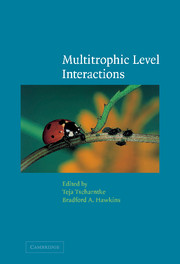Book contents
- Frontmatter
- Contents
- List of contributors
- 1 Multitrophic level interactions: an introduction
- 2 Plant genetic variation in tritrophic interactions
- 3 Multitrophic/multispecies mutualistic interactions: the role of non-mutualists in shaping and mediating mutualisms
- 4 Tritrophic interactions in tropical versus temperate communities
- 5 Endophytic fungi and interactions among host plants, herbivores, and natural enemies
- 6 Multitrophic interactions in space: metacommunity dynamics in fragmented landscapes
- 7 The chemical ecology of plant–caterpillar–parasitoid interactions
- 8 Canopy architecture and multitrophic interactions
- 9 Tritrophic below- and above-ground interactions in succession
- 10 Multitrophic interactions in decomposer food-webs
- Index
4 - Tritrophic interactions in tropical versus temperate communities
Published online by Cambridge University Press: 08 August 2009
- Frontmatter
- Contents
- List of contributors
- 1 Multitrophic level interactions: an introduction
- 2 Plant genetic variation in tritrophic interactions
- 3 Multitrophic/multispecies mutualistic interactions: the role of non-mutualists in shaping and mediating mutualisms
- 4 Tritrophic interactions in tropical versus temperate communities
- 5 Endophytic fungi and interactions among host plants, herbivores, and natural enemies
- 6 Multitrophic interactions in space: metacommunity dynamics in fragmented landscapes
- 7 The chemical ecology of plant–caterpillar–parasitoid interactions
- 8 Canopy architecture and multitrophic interactions
- 9 Tritrophic below- and above-ground interactions in succession
- 10 Multitrophic interactions in decomposer food-webs
- Index
Summary
Introduction
The latitudinal gradient in diversity is one of the oldest (e.g., Wallace, 1878) and most obvious trends in ecology, and a wealth of literature is devoted to understanding both the causes and consequences of this gradient (Dobzhansky, 1950; also reviewed by Rohde, 1992). Given the enormous latitudinal differences in both diversity and productivity between temperate and tropical habitats, it is likely that relationships among trophic levels may also be fundamentally different. Although trophic interactions can be complex, a current research goal in community ecology is to determine which populations at different trophic levels are limited due to resource availability and which are limited due to consumption by higher trophic levels. In this chapter, we review the literature to determine if latitudinal trends exist for trophic controls. Identifying these patterns should help clarify whether ecological paradigms developed in temperate systems are useful for understanding tropical systems. Tropical ecologists, conservation biologists, and agricultural scientists have suggested that many ecological paradigms do not apply to tropical systems and should not be used to make management decisions or theoretical assumptions. Another advantage of identifying latitudinal gradients in tritrophic level interactions is that many of the hypotheses attempting to explain the latitudinal gradient in diversity are based on untested assumptions about the differences between tropical and temperate communities.
- Type
- Chapter
- Information
- Multitrophic Level Interactions , pp. 67 - 88Publisher: Cambridge University PressPrint publication year: 2002
- 38
- Cited by

